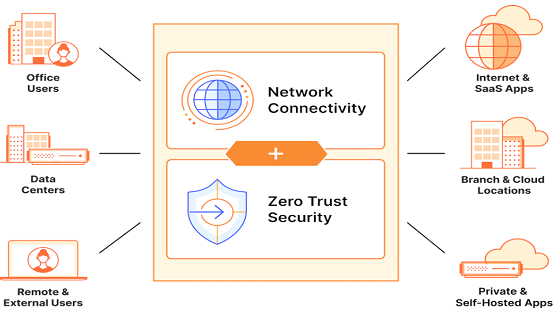There has been an increasing complexity and demands of modern IT environments to accommodate organizations expanding their digital footprint with cloud-based services, remote workforces, and global operations. The current traditional network architectures and security measures are struggling to keep up. These legacy systems often lead to inefficiencies, higher costs, and vulnerabilities due to their fragmented nature. SASE addresses these challenges by converging networking and security into a single, cloud-native service, which simplifies management and enhances scalability.
What is SASE?
Secure Access Service Edge (SASE, pronounced “sassy”) is a framework that integrates cloud and local networking with network security services. It operates as a unified outsourced service, typically offered by a single provider or carrier.
How does it work?
SASE is not a single technology but rather multiple technologies. It focuses on securing all devices, users, applications, services, and data, regardless of their location. This fundamentally means that access decisions are primarily based on user identities, not physical locations or network topology.
SASE services are offered through a network of globally distributed points of presence (PoPs) managed by the provider. When a user or device tries to access a resource, such as an application in a data center or cloud, the request is routed to the nearest PoP. This PoP enforces the necessary security policies and directs the traffic accordingly.

Why use SASE?
Here are some reasons to use SASE, to help businesses assess if it aligns with their business needs.
⦁ Improved Performance: Optimizes network performance by directing traffic to the nearest point of presence (PoP).
⦁ Enhanced Security: Combines network security services like Firewall, VPN, and secure web gateways into a single solution.
⦁ Simplified Management: Centralizes and simplifies the management of network and security policies.
⦁ Cloud-Native Architecture: Ideal for organizations leveraging cloud-based applications and services.
⦁ Consistent Policy Enforcement: Ensures security policies are consistently applied across all users and devices.
SASE Challenges
While SASE offers significant benefits, there are some challenges associated with its implementation and operation:
⦁ Complexity of Integration: Integrating SASE with existing network and security infrastructure can be complex. Organizations often have a mix of legacy systems and modern applications, which can make seamless integration difficult. Transitioning to a SASE model requires careful planning and execution.
⦁ Vendor Lock-In (Sticky): Choosing a single SASE vendor can lead to dependency on that vendor’s solutions and technologies, which could make it challenging to switch vendors in the future or integrate best-of-breed solutions.
⦁ Reliability and Availability: Relying on a cloud-based SASE provider means that organizations are dependent on the provider’s uptime and reliability. Any outages or disruptions in the provider’s service can impact the organization’s access and security.
How SASE is different from VPN
With all this about SASE, I am sure you are wondering where the VPN service that you might be used to stands. While both Remote access solutions (RAS) promise users easy, fast, reliable, and secure access to the corporate network from any location. SASE offers a more modern and versatile approach to network and security, making it a strong choice for organizations adapting to the evolving IT landscape. VPNs remain relevant but are better suited for more traditional networking needs.
The main difference between SASE and VPN
Based on SASE design, it can help you optimize network performance, while VPNs can sometimes introduce latency and bandwidth limitations. If we analyze the security features offered by both, SASE includes comprehensive security features like firewall, anti-malware, and zero trust network access (ZTNA), while VPN primarily focuses on creating a secure tunnel for data transmission.
While SASE provides a modern and holistic solution for remote access and network security, it is unlikely to fully replace VPNs in every situation. Some organizations may still favor VPNs for their ability to offer more detailed control over network access or to meet specific compliance demands. The decision between using SASE or VPNs should be based on the unique needs and considerations of your business.
To conclude, SASE unified approach provides businesses with the agility to quickly adapt to changing market conditions, improve user experience through optimized network performance, and maintain robust security postures across all access points, ultimately driving greater business value through operational efficiency and reduced risk.ns to keep your business safe. Contact us today to get started.



